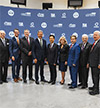Frontline: Drones Redefine the Use of Commercial Airspace
The FAA is in the process of establishing regulations for the commercial use of drones, the use of which is also supposed to be a boon to the telecommunications industry.
Directory 2016

Guidelines
The FAA is struggling to keep up — the administration had targeted September 2015 for establishing regulations for commercial use of drones, but that date has now been pushed back to 2016. It has, however, issued a draft proposal that discusses operational limitations, operator certification and responsibilities, aircraft requirements, and model-aircraft operator responsibilities. And, in November 2015, the FAA released new guidance for the monitoring of recreational drones, including creating a database for privately owned drones.
One of the most promising commercial aspects of UAVs remains their capacity to collect, store, analyze, and transmit vast amounts of valuable data. David Famolari, director for Verizon Ventures Amazon has proposed two low-altitude layers of airspace for drones — a “slow lane” for local traffic below 200 feet and a “fast lane” between 200 and 400 feet. The 400–500-foot layer would be a no-fly zone. The FAA is working with NASA and the private sector to work out a myriad of operational and technical details, including tracking technology and crash prevention. For example, Verizon, Google, and Amazon are collaborating with NASA to explore the possibility of using cell towers to help monitor drones and exchange critical information between UAVs and operators.
The drone business is expected to skyrocket when the FAA does establish its guidelines, whenever that may be. Private-sector companies across a wide range of industries are expected to invest heavily in drones to increase their operational efficiencies and reduce risk.
Impact on Telecommunications
Experts project that the use of drones will create more than 100,000 jobs and generate nearly half a billion dollars in tax revenue by 2025. Drones are also expected to be a huge boon to the telecommunications industry, especially wireless companies that invest in advanced technologies such as LTE (long-term evolution), a wide-area wireless technology that makes it possible for drones to transmit vast amounts of data at fast speeds across long distances.
“One of the most promising commercial aspects of UAVs remains their capacity to collect, store, analyze, and transmit vast amounts of valuable data,” says David Famolari, director for Verizon Ventures, a division of Verizon that invests in disruptive, cutting-edge technologies. “UAV devices use LTE networks to deliver sensor data for processing, analysis, and decision-making mid-flight, as well as for receiving command-and-control inputs in real time. Flight coordinates could be delivered over the network to dynamically update flight plans, reroute missions, and clear airspace when necessary. LTE connectivity gives UAV operators real-time visibility beyond the line of sight, allowing them to better manage their fleets, track aircraft, and run more efficient operations. Simply put, UAVs connected to an LTE network will be safer, more reliable stewards of shared airspace.”
Project Announcements
Denmark-Based Novonesis Expands Salem, Virginia, Production Operations
05/04/2025
GE Aerospace Expands Batesville, Mississippi, Manufacturing Operations
04/20/2025
Yeadon Fabric Domes Plans Fayetteville, North Carolina, Manufacturing Operations
03/24/2025
Kratos Defense & Security Solutions Plans Odon, Indiana, Operations
03/24/2025
AJG Aerospace Plans Oakland County, Michigan, Manufacturing Operations
03/23/2025
CG Model Tek Expands Coffee County, Tennessee, Manufacturing Operations
03/16/2025
Most Read
-
Run a Job Task Analysis
Q4 2024
-
39th Annual Corporate & 21st Annual Consultants Surveys: What Business Leaders and Consultants Are Saying About Site Selection
Q1 2025
-
The Location Economics of Advanced Nuclear
Q1 2025
-
Why Workforce Readiness Can’t Wait
Q1 2025
-
Power, Policy, and Site Selection in 2025
Q1 2025
-
Is It Time to Start Planning for Quantum Data Centers?
Q1 2025
-
Top States for Doing Business in 2024: A Continued Legacy of Excellence
Q3 2024



